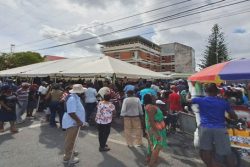Stabroek News yesterday protested outside of the Commonwealth finance ministers meeting over the government’s withdrawal of state advertising but its employees were prevented from holding placards in what Editor-in-Chief David de Caires said was a breach of its democratic right.
The protest planned for outside the Guyana Inter-national Conference Centre was to draw international attention to government’s withdrawal of ads from the newspaper a year ago.
The picket was meant to coincide with the meeting of officials preparing for the opening of the Common-wealth Finance Ministers’ Meeting last evening at the National Cultural Centre.
Reacting to the police restrictions, de Caires said that “It was wrong preventing us from demonstrating our concerns. We had given proper notice under the Public Order act.” He said he asked the police to explain why the newspaper could not picket outside the conference centre but he was given no credible response.
He added, “It is part of our standard democratic right to run a peaceful picket on the road outside the conference hall and not three hundred yards away in the same manner that people picket outside the White House and parliaments.”
On arrival at the barriers, the Stabroek News demonstrators were told that they would only be allowed to picket some 300 yards away from the conference centre and objected to this, with one saying that the action was “a breach of our democratic rights. We are not a threat to security in any shape or form.”
While permission was not required to hold a peaceful picket, de Caires said that Stabroek News nevertheless informed the police about a week ago of its intention to picket yesterday. The restrictions, he said, pointed to a dangerous regression here.
Despite repeated attempts, Stabroek News was unable to contact the Commander of `C’ Division, Leroy Brummel for an explanation of the police decision to ban the placards.
Eventually, the police allowed some of the picketers on the road outside the conference centre but without their banners and placards. Others remained 300 yards away holding the placards and the banners. Deprived of their placards, those outside the conference held aloft copies of Stabroek News to chants of among others slogans “Press Freedom – under attack”, “One year – too long”, “Conduct a study – Restore the ads.”
Some remained the 300 yards away with two banners, which read “President Jagdeo – Press Freedom is the nation’s lifeblood” and “Withdrawal of ads is an attack on press freedom.”
Some of the placards read “We pay taxes too”, “State ads are paid for with our money”, “Government ads should be circulated, not dictated”, “We shall not be silenced, we will continue to tell the truth”, and “Our liberties depend on freedom of the press.”
Noting that it is almost one year since the government pulled its ads from the Stabroek News, de Caires told the regional and international media that it was hard to estimate the full impact that the withdrawal of the ads from 29 government ministries and state agencies has had on the newspaper but added that it accounted for 20% of the gross advertising revenue.
“We are running a tight ship,” he said noting that the advertising revenue was not President Bharrat Jagdeo’s money, “It is my money, your money, our money.”
He recalled persuading Jagdeo, several years ago to subscribe to the Declaration of Chapultepec in which its Principle 7 states that “the granting or withdrawal of government advertising may not be used to reward or punish the media or individual journalist.”
De Caires recounted the many efforts made to resolve the issue including by a group of regional media practitioners comprising publisher Harold Hoyte, President of the Association of Caribbean Media (ACM) workers, Dale Enoch; and Guyanese/ Caribbean journalist Ricky Singh who made some suggestions which included the auditing of the local dailies and the sharing of ads based on scientific findings.
The rejection of the suggestions, de Caires said, was “A slap in the face of the regional media” adding that to date the government has resisted all calls from local, regional and international organizations, including media groups, the political opposition, trades unions, private sector organizations and the Guyana Human Rights Association to review the allocation of the ads.
He noted, too, that in June the Special Rapporteur of the Inter-American Commission on Human Rights (IACHR) had written the government as to its reasons for the withdrawal of the ads but no response has been given.
“We don’t want a monopoly,” he said noting that from the inception the Stabroek News had urged the government to conduct an audit of the three dailies as well as the Mirror newspaper which is aligned to the PPP/C government and have a reputable advertising agency allocate the ads based on the target audience.
In brief remarks, Guyana Press Association (GPA) President, Dennis Chabrol said that the picket was meant to bring attention to how the government was using taxpayers’ money to severely punish the Stabroek News which has one of the largest newspaper circulations in the country and has a variety of news apart from the run-of-the-mill crime and politics.
He said he saw the withdrawal of the ads as a sinister move to silence the Stabroek News for its editorial content.
The GPA, he said, was not saying to the government to give Stabroek News all the ads but to revamp the allocation of ads on the basis of a scientific study.
City Mayor Hamilton Green, who joined in the protest, said that the denial of the ads was an indication that the Jagdeo government was unconcerned about the state of affairs of its citizenry.
University of Guyana senior lecturer, Dr Joyce Jonas said that she joined the picket line because she saw the Stabroek News “as the only newspaper in Guyana at the moment which was attempting to uncover the truth. If that voice is silenced, then the whole country is in for a whole lot of trouble.”
Stabroek News staffer, Doreen Jeetlall said, “We fought for free and fair elections, we were good then. Now we are trying to maintain transparency and we’re despised.”
PPP/C MP and former Information Minister Moses Nagamootoo, who was cornered by the media while stopping at the 300 yard barrier said when asked “I called for freedom of the press. Press freedom should live in Guyana.”
Stabroek News reporter, Iana Seales, who joined the Stabroek News five years ago said that “as a young journalist, I am not encouraged to stay on in this country, knowing that I cannot write freely and make my contribution to a democratic society.”
Journalists from some private media houses also joined the picket.
The government has consistently said that the withdrawal of the ads was based on a decline in the newspaper’s circulation. It has not provided any substantiation for this neither has it responded to reasonable proposals for a resolution of the dispute.





